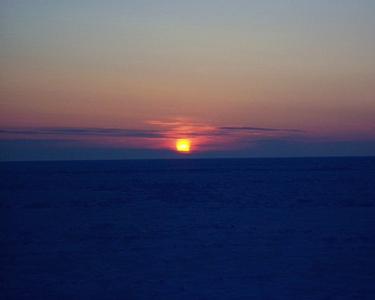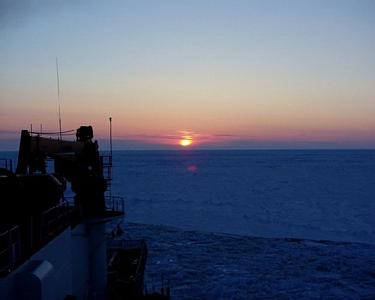
|
8 May, 2000Sunrise and Sunset DRAFT May 8, 2000 Daily Data (20:30): Lat. 6835.725663N Long. 06105.600241W Heading 21.798 Air Temp. -10.17C 13.69F True Wind Dir. 270 True Wind Speed 10 knots USCGC Healy Facts: Accommodations: 12 Officers, 10 CPO (Chief Petty Officers), 53 Enlisted, 35 Scientists, 15 Surge, 2 Visitors Inuit Language Lesson from Stevie Audlakiak and James Qillaq: Nanook (nah’ nook): Bear Nautek (na’ teck): Seal Dear Everyone, I've noticed that as the days progress and as we proceed further north, they seem to be getting longer. Everyone appears to work longer and be up later at night. To me, it doesn't seem as though we have what I'd typically call night. Wondering if we are simply in the twilight zone, I went up to the bridge the other evening and found Robert Wolfe, a Research and Development Officer, from Ottawa, Ontario, Canada. Robert shared with me some interesting trivia that he found in some nautical books housed in the Healy's bridge. We began discussing sunset and the various forms of twilight. Vocabulary of the day: Below are some of the nautical terms that I learned from talking to Robert Wolfe as well as from reading sections of the publication, THE AMERICAN PRACTICAL NAVIGATOR. Sunset: “The crossing of the visible horizon by the upper limb of the setting sun.” This is the time that the top crest of the sun (the upper limb) goes below or sets at the horizon. The periods of twilight are categorized by the depression of the sun below the horizon. There are three types of twilight that occur before sunrise and after sunset, these being: civil, nautical and astronomical. On any ship, such as with my case on the Healy, there is a second publication which is produced annually called THE NAUTICAL ALMANAC that states not only the times of both sunrise and sunset, but also the times of Civil and Nautical Twilight, solely based upon an individuals latitude. Civil Twilight: "The period of incomplete darkness when the upper limb of the sun is below the visible horizon, and the center of the sun is not more than 6 degrees below the horizon." This would be the time when the western (setting) or eastern (rising) sky would be orange and there would be enough light to be able to drive without your lights on. Nautical Twilight: "The time of incomplete darkness which begins (morning) or ends (evening) when the center of the sun is 12 degrees below the celestial horizon." This form of twilight covers the period of time when the sun's position is between 6 degrees and 12 degrees below the horizon. During the period of Nautical Twilight the horizon is generally just visible and it is also the same period in which the brightest stars and planets become visible to the naked eye. This brief period of time (typically 30 minutes) is when sextant angles of the various heavenly bodies can be measured off the horizon that will help tell a navigator where their ship is on the ocean, hence the term Nautical Twilight’. Astronomical Twilight: This last form of twilight occurs when the sun's position is between 12 degrees and 18 degrees below the horizon. This phase marks the time when the horizon is no longer visible and some of the dimmer stars begin to appear as the transition to night or darkness occurs. Because of the combined effect of having the earth tilted on its axis as it rotates around the sun, different parts of the earth receive varying amounts of sunshine. This creates what we've grown accustomed to as the four seasons. When the sun gives equal amounts of light to both the northern and southern hemisphere due to its location over the equator, the phenomena is called an Equinox. The dates for an equinox are usually March 21 and September 21. Three months later when the sun's position is either at it's extreme northern or southern position in the sky, those events are called Solstice’ meaning that the sun stands still. Lines drawn on maps indicate these positions. In the northern hemisphere a line drawn at 23 degrees 26 minutes North is called the Tropic of Cancer’ and in the southern hemisphere the line situated at 23 degrees 26 minutes South is called the Tropic of Capricorn’. For people living in the Northern Hemisphere, June 21 is our Summer Solstice’ and December 21 would be our Winter Solstice’. What time is your sunrise or sunset? Using THE NAUTICAL ALMANAC, for 2000, and based upon our latitude of 68 degrees 35.7 minutes North (roughly 68 degrees), I determined that our sunrise this morning was at 2:27 AM and our sunset will occur this evening at 9:29 PM. Due to our high latitude in relation to the sun's position, THE NAUTICAL ALMANAC also stated that we will not experience nautical twilight either in the morning or in the evening. Since there are no times listed for civil twilight, we know that after the sun sets it will remain between 0 degrees and 5 degrees 59 minutes below the horizon until it rises again in the morning. We will not experience night’. If we took our 24 hour calendar cycle, we would experience 2:27 + (12 - 9:29) = 2:27 + 2:31 = 4:58 hours of civil twilight and 19:02 hours of sunshine on a clear day. For this current year, if you were living in the Nunavut community of Broughton Island at about 68 degrees North, January 4 would have been the first day of New Year in which you would see a sliver of the sun, enough to constitute a sunrise. May 24 would be the first day of 24-hour continuous daylight that would last right through till July 14. Later on July 17 you would see your first sunset after the peak of summer and finally on December 8 the community would be plunged into total darkness until the New Year. Other communities further north would experience longer periods of both total daylight and darkness. Remember that this experience is not necessarily reserved for the far north. If you went to Antarctica and passed the Antarctic Circle your year could resemble that of your northern neighbors except that the seasons would be directly opposite. How long is your day? If you for example lived at 40 degrees North latitude, which from west to east in the United States places you in: Reno, Denver, Kansas City, Indianapolis or Philadelphia your 24 hour cycle would be quite different than mine. For the eighth of May you would have: 7:38 hours of night 0:37 minutes of morning nautical twilight 0:30 minutes of morning civil twilight 14:08 hours of daylight 0:37 minutes of evening nautical twilight + 0:30 minutes of evening civil twilight 24:00 One revolution of the earth References: THE AMERICAN PRACTICAL NAVIGATOR, AN EPITOME OF NAVIGATION, 1995 edition, by Nathaniel Bowditch, LLD, published by the Defense Mapping Agency Hydrographic/Topographic Center, Bethesda, MD. THE NAUTICAL ALMANAC, for the year 2000, issued by both the Nautical Almanac Office, United States Naval Observatory and in London by Her Majesty's Nautical Almanac Office. ISBN 0 - 16 - 050021 - 4. It is with thanks and appreciation to Robert Wolfe for his assistance and expertise in writing this journal entry for you. Best regards, Sandra For photos and more: ../tea_kolbfrontpage.html For further information: ../ http://www.uscg.mil./pacarea/healy
Contact the TEA in the field at . If you cannot connect through your browser, copy the TEA's e-mail address in the "To:" line of your favorite e-mail package. |






